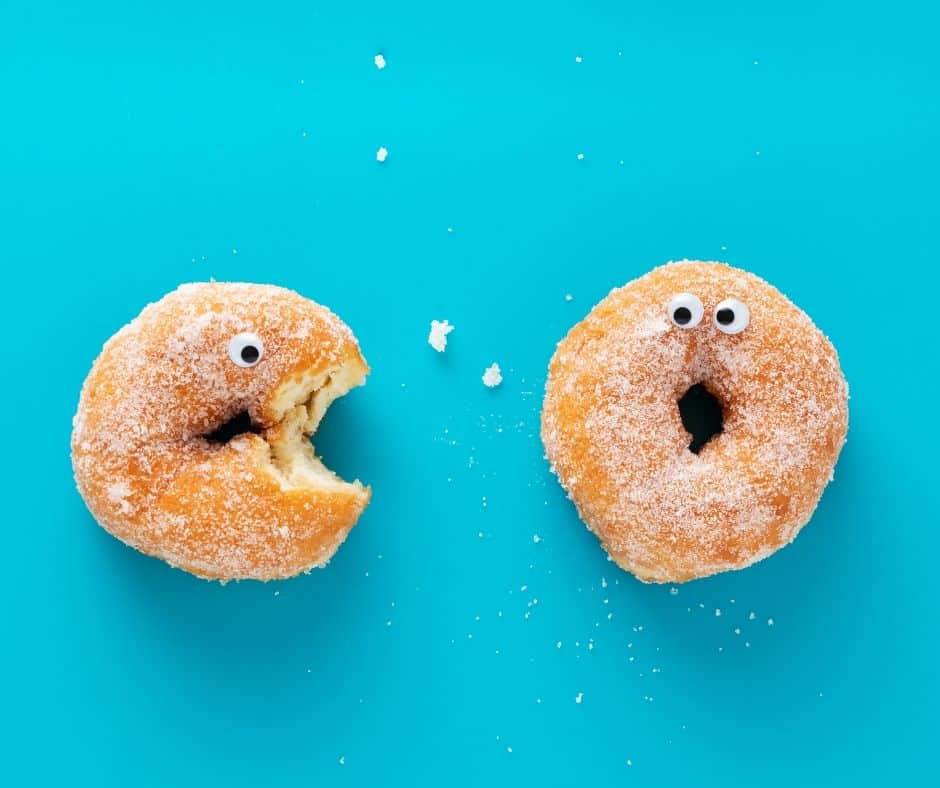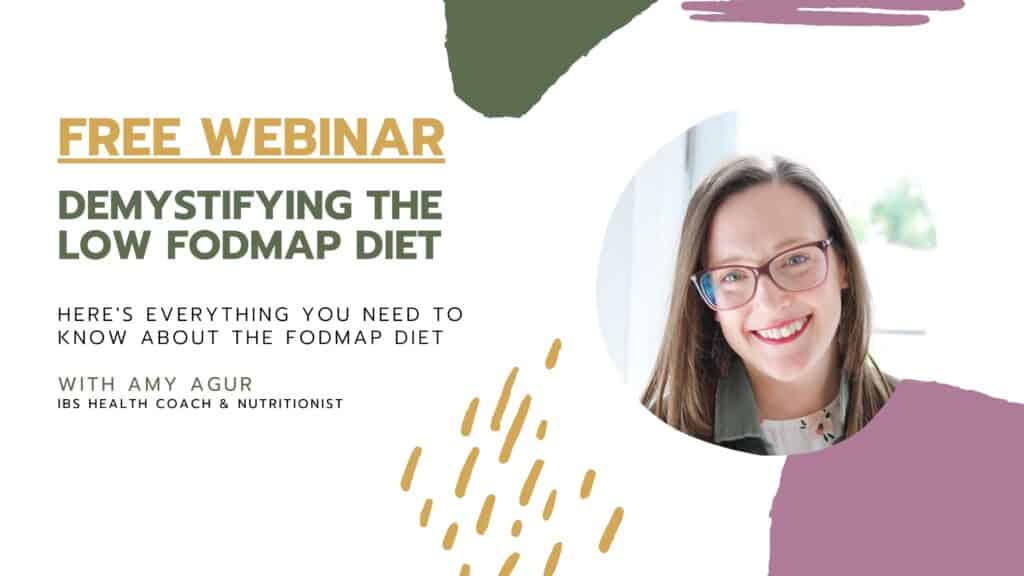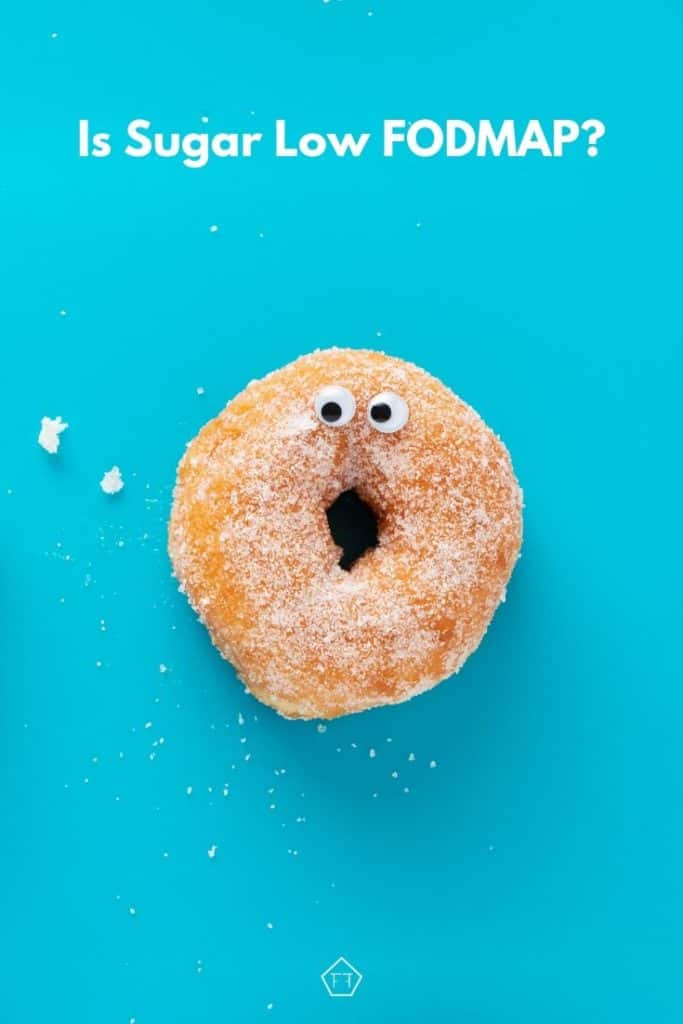Wondering if sugar is low FODMAP? Sugar gets a bit of a bad wrap on the low FODMAP diet. But today we’re going to set the record straight. Buckle up, friend! We’re about to get our nerd on.

Understanding sugar and the low FODMAP diet
The first thing you need to know is that when we talk about sugar and the low FODMAP program, we’re talking about “sucrose.”
Sucrose is a disaccharide, which is a fancy way of saying it’s a compound made of two molecules bonded together. “Disaccharides” might sound familiar, because they are the “D” in FODMAP. But, the low FODMAP program is only concerned with one disaccharide – lactose. So settle down there partner, we’re still in the clear!
The second thing you need to know is that sucrose is made of one glucose molecule and one fructose molecule. Did the hair on the back of your neck stand up? Don’t panic, friend! I’ve got you!
During the elimination phase of the low FODMAP program, you’re looking for two types of fructose. Fructose floating around on its own (like in fruit, or as an added sweetener) and fructose that appears “in excess of glucose.” Which is just a fancy way of saying there is more fructose than glucose in a product (like in glucose-fructose or high fructose corn syrup).
The good news is since sucrose is made of equal parts glucose and fructose, it’s low FODMAP.
Why do we avoid fructose on the low FODMAP diet?
To understand why sugar is low FODMAP, there are a few things you’ll need to know. First, why the heck are we avoiding fructose in the first place?
Fructose is a special FODMAP because it’s the only monosaccharide tested in the low FODMAP program. Monosaccharides, the “M” in FODMAP, are single molecules. So, unlike FODMAP chains like lactose, fructans, and GOS, etc. they don’t need to be broken down into smaller parts to be absorbed into the bloodstream.
Heads up, molecules don’t just walk out of your intestine. They’re transported through the intestinal membrane by specific “transporters.” Fructose is carried out of the gut through a transporter called GLUT-5. We’ll call it a shuttle bus to keep things simple.
In some people with IBS, the fructose shuttle bus has a flat tire. So fructose molecules have to hitchhike to the next exit (through your large intestine). While they’re moving through your gut, they can get up to all kinds of trouble! They can pull water into your intestines, causing painful cramping and diarrhea. Plus, when they reach the large intestine, they’re gobbled up by your gut bugs and fermented, which can cause excess gas (um, no thanks!).

If sugar contains fructose, why is it low FODMAP?
Like I mentioned above, sucrose is made of equal parts glucose and fructose (1 glucose + 1 fructose = 1 sucrose).
This is important because glucose molecules are absorbed into the bloodstream using two different transporters: SGLT-1 and GLUT-2. Lucky for us, the GLUT-2 shuttle bus can accept fructose molecules as long as they’re paired with a glucose buddy. So when you eat foods with an equal amount of glucose and fructose, the fructose is absorbed correctly.
Because there’s no fructose left wandering around your gut, sucrose is low FODMAP. Sweet tooths rejoice!
Are all sugars low FODMAP?
So, now that you know sucrose is low FODMAP, you may be wondering are all sugars low FODMAP? The short answer is no.
Depending on where they come from and how they’re manufactured, not all forms of sugar have an equal amount of glucose and fructose. For the record, many common sugars like table sugar, brown sugar, cane sugar, raw sugar, or icing sugar are low FODMAP. While other sugars, like coconut sugar, “fruit” sugar, and palm sugar are high FODMAP.
A little bit yummy has a fantastic article about low FODMAP sugars and sweeteners and how they’re made. You can also check your Monash app for a full list of low FODMAP sugars and sweeteners and their serving sizes.
How much sugar can you eat on the low FODMAP diet?
If the fructose in sugar is absorbed correctly, is there a limit to the amount of sugar you can eat on the low FODMAP diet?
If you look at the Monash University app, you’ll see most sugars have a recommended serving size of 40-50 g or about 1/4 cup. But, this limit is based on the current Australian dietary guideline, not the FODMAP content.
While you could technically eat a bucket of sugar without exceeding your FODMAP load, anyone who has survived a Halloween or two knows that excess sugar is a gut irritant. So, while sugar doesn’t become high FODMAP in larger servings, it should still be enjoyed in moderation.
For my Canadian peeps, the Heart and Stroke Foundation of Canada recommends a limit of 48 g (about 4 tbsp) of added sugar per day. So don’t go crazy!
Does adding glucose make high-fructose foods safe?
Wondering if taking a glucose supplement will help you absorb foods high in fructose? While I applaud your creative thinking, Monash University tested this theory and couldn’t find any evidence to support the idea that eating glucose and fructose together increases the absorption of fructose molecules.
What is the difference between fructose malabsorption and fructose intolerance?
Just so we’re clear, people with IBS who are “sensitive” to fructose are suffering from “fructose malabsorption,” meaning fructose molecules aren’t absorbed correctly by the intestine.
Fructose intolerance (also called hereditary fructose intolerance or HFI) is a hereditary metabolic disease. People with HFI suffer from a genetic mutation that prevents their body from making the enzyme needed to break fructose down when it reaches the liver.
To manage their symptoms, people with HFI need to eliminate all sources of fructose from their diets, including low FODMAP sugars like table sugar, natural sweeteners, and fruits.
Heads up, many people with HFI hang out in the online low FODMAP community, as many low FODMAP recipes are suitable for an HFI diet. Just so you know, if you see a comment warning that a food or recipe isn’t safe for people with fructose intolerance, don’t panic! It’s still safe for you.
Final thoughts on sugar and the low FODMAP diet
That was a ton of information, so let’s take a minute to recap! While sugar isn’t particularly good for you, because sucrose is made of equal parts glucose and fructose, it’s absorbed differently than fructose molecules on their own. Since no stray fructose molecules are floating around your digestive tract, sugars created from sucrose are low FODMAP and can be safely enjoyed in moderation.
You might also like one of these articles:
- What Are Probiotics and Prebiotics? Wondering if adding probiotics or prebiotics to your daily routine will help tame your IBS symptoms? Here’s the scoop on how these cheeky little bugs can help or hurt you.
- Why Do IBS Symptoms Flare During Your Period? Have you ever noticed your IBS symptoms always seem to flare up during your period? Here’s everything you need to know about how and why your cycle can throw a monkey-wrench in your gut!
- Can Food Sensitivity Tests Identify IBS Food Triggers? Wondering if a food sensitivity test can help you identify your IBS triggers? Here’s everything you need to know about food sensitivity tests and what they mean for people with IBS.
If you like this post, don’t forget to share it! Together we’ll get the low FODMAP diet down to a science!
References
- Agur, A. M., Dalley, A. F., & Grant, J. C. (2017). Grants atlas of anatomy (14th ed.). Wolters Kluwer.
- Chen, L., Tuo, B., & Dong, H. (2016). Regulation of Intestinal Glucose Absorption by Ion Channels and Transporters. Nutrients, 8(1). doi:10.3390/nu8010043
- Marieb, E. N. (2004). Human anatomy & physiology (6th ed.). San Francisco, CA: Pearson Benjamin Cummings.
- Martini, F., Ober, W. C., Nath, J. L., Bartholomew, E. F., Garrison, C. W., Welch, K., & Martini, F. (2011). Visual anatomy & physiology. Boston: Benjamin Cummings.
- Moore, K. L., Agur, A. M., & Dalley, A. F. (2015). Essential clinical anatomy (5th ed.). Wolters Kluwer.
- Moore, K. L., Dalley, A. F., & Agur, A. M. (2017). Moore Clinically oriented anatomy (8th ed.). Wolters Kluwer/Lippincott Williams & Wilkins.
- Noelting, J., & DiBaise, J. K. (2015). Mechanisms Of Fructose Absorption. Clinical and Translational Gastroenterology, 6(11). doi:10.1038/ctg.2015.50
- Tortora, G. J., & Derrickson, B. (2012). Principles of anatomy & physiology(13th ed.). Hoboken, NJ: John Wiley & Sons.

